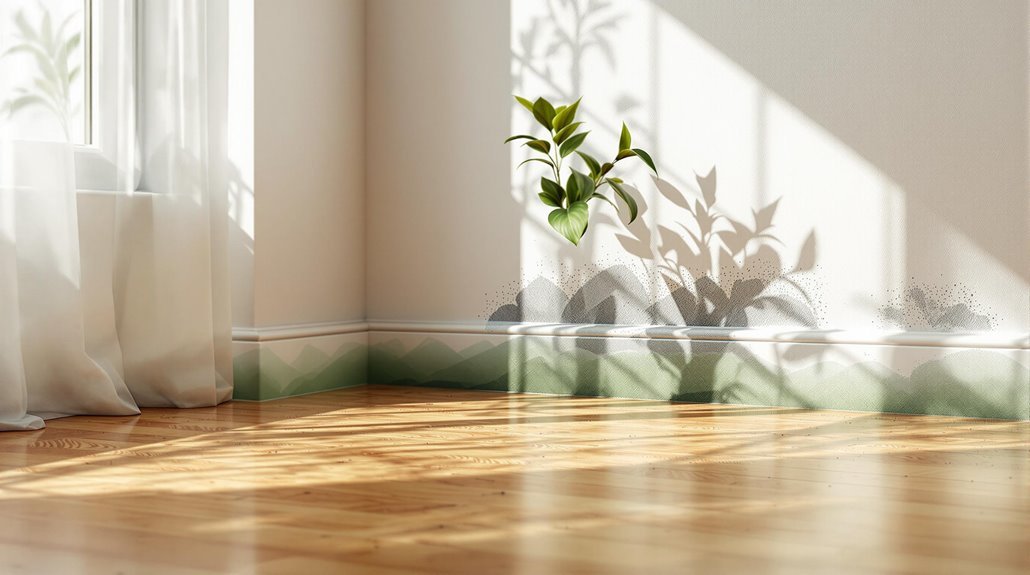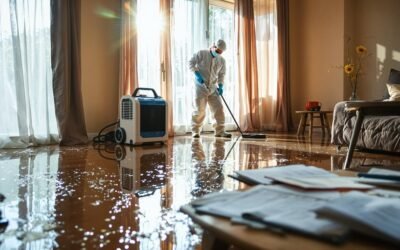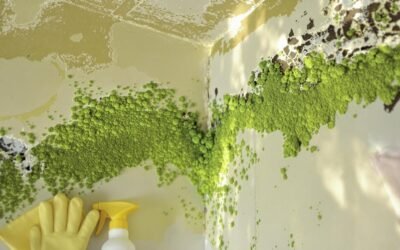Yes, mold can develop without visible signs of water damage. It thrives in hidden, damp areas with humidity levels exceeding 60%. Small leaks from pipes or appliances, condensation on cold surfaces, and poorly ventilated spaces can all create conditions favorable for mold growth, often invisibly. Unexplained musty odors or discoloration might suggest hidden mold regardless of whether you can't see any water damage. Since mold exposure carries health risks, including respiratory issues and allergic reactions, you must take preventive measures against moisture. Understanding these factors is crucial for mold prevention and health safety. Further insights await you.
Key Takeaways
- Mold can grow when humidity exceeds 60%, even without visible water damage.
- Small leaks or hidden moisture sources can create ideal conditions for mold growth.
- Discoloration on walls or musty odors may indicate mold hidden behind surfaces.
- Poor ventilation in areas like basements can lead to undetected mold issues.
- Regular inspections and moisture assessments are crucial for early mold detection.
Understanding Mold Growth Conditions
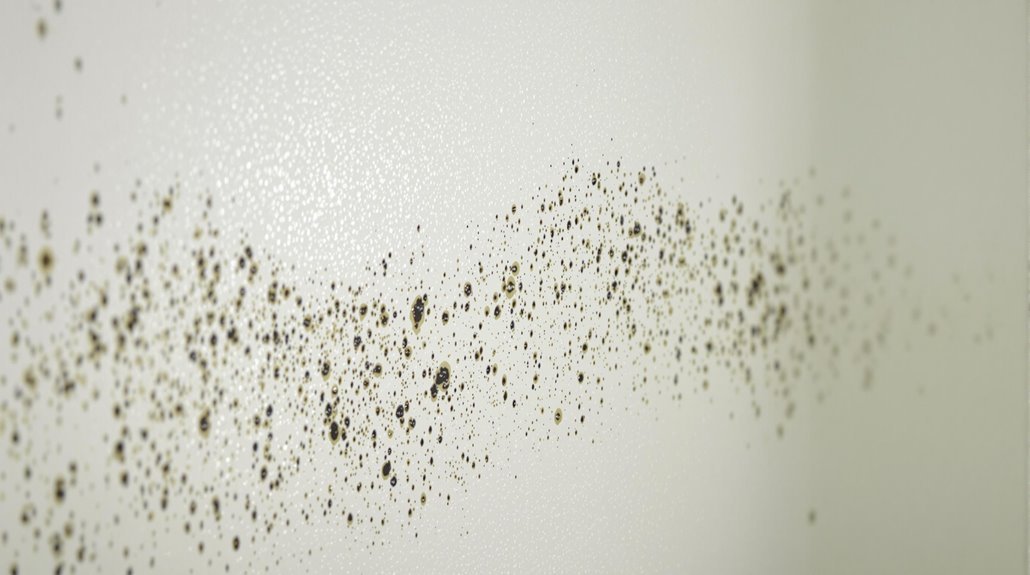
Although you might not see visible signs of mold, understanding the conditions that promote its growth is crucial. Mold thrives in specific environmental factors, which include temperature, humidity, and nutrient availability. The mold lifecycle begins with spores that require moisture and organic materials to germinate. When relative humidity exceeds 60%, mold spores become active and start to colonize. This process can unfold rapidly, often without observable signs. Dark, warm, and damp areas provide ideal conditions, allowing mold to flourish. In addition, even small, undetected leaks can create an environment favorable to growth. Recognizing these environmental factors helps you prevent mold outbreaks before they escalate, ensuring a healthier living space. Professional services can ensure thorough assessment and remediation of any hidden mold issues.
Hidden Sources of Moisture
While you may think your home is dry, hidden sources of moisture can lurk in unexpected places, creating an ideal environment for mold growth. Addressing these moisture sources is crucial to prevent condensation issues that might go unnoticed. Consider these potential culprits:
- Leaky Pipes: Even small leaks can create a damp environment.
- Basements and Crawl Spaces: These areas often retain moisture, especially if poorly ventilated.
- Condensation: Humidity on cold surfaces, like windows and walls, can lead to moisture accumulation.
- Appliances: Dishwashers and washing machines can harbor leaks that contribute to excess moisture.
Additionally, prompt action to address these issues can significantly reduce the risk of mold development in your home.
Health Risks of Hidden Mold
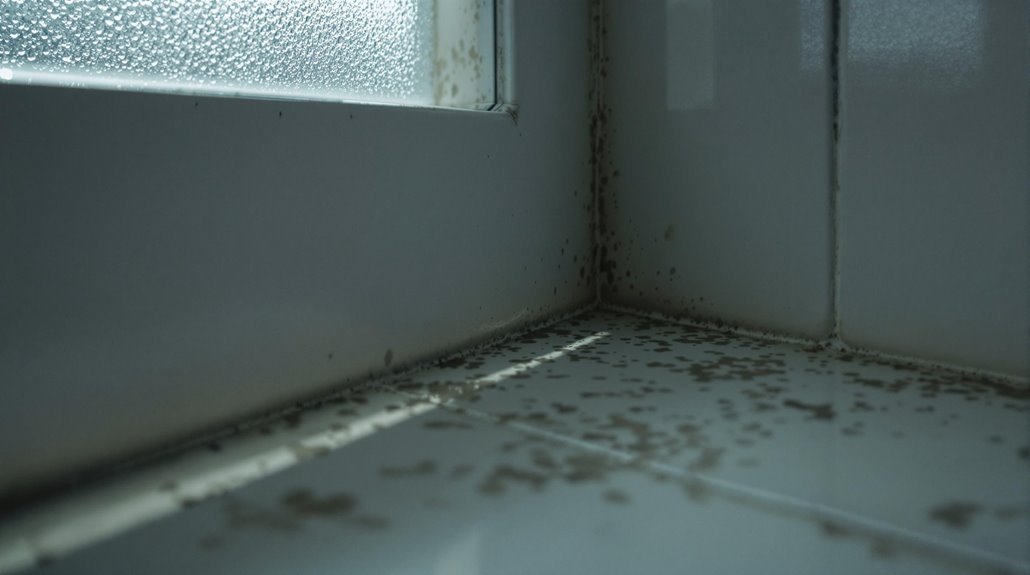
Hidden moisture can lead to mold growth that often goes unnoticed, posing significant health risks. When you experience mold exposure, even in small amounts, it can trigger various health symptoms. Common reactions include respiratory issues, allergic responses, and skin irritations. People with pre-existing conditions, such as asthma or compromised immune systems, are particularly vulnerable. Research indicates that prolonged exposure can worsen these symptoms, leading to chronic respiratory problems and other serious health concerns. Moreover, some molds produce mycotoxins, which can contribute to neurological symptoms and long-term health issues. Recognizing the dangers of hidden mold is essential for maintaining a healthy indoor environment, as early intervention can prevent more severe health complications down the line.
Prevention Strategies for Homeowners
Since mold can thrive in damp environments without obvious signs, homeowners must implement effective prevention strategies to mitigate the risk. Here are some crucial mold prevention tips focused on moisture control:
- Maintain Low Humidity: Keep indoor humidity below 60% using dehumidifiers or air conditioning.
- Guarantee Proper Ventilation: Use exhaust fans in kitchens and bathrooms to reduce moisture buildup.
- Fix Leaks Promptly: Address any plumbing leaks or water intrusion immediately to prevent mold growth.
- Inspect and Clean Gutters: Regularly check and clean gutters to guarantee proper drainage and avoid water pooling around your home.
Identifying Signs of Hidden Mold

Although mold often goes unnoticed, there are several telltale signs that can indicate its presence in your home. Look for unexplained musty odors, as they often signal hidden mold. Discoloration on walls or ceilings, even when subtle, may likewise suggest mold growth behind the surface. Utilize mold detection techniques like air sampling or surface testing to confirm your suspicions. In addition, moisture assessment methods such as humidity readings can help identify areas prone to mold, especially in bathrooms and basements. Regularly inspect for leaks or condensation, as these can create the ideal environment for mold proliferation. By staying vigilant and proactive, you can effectively identify and address hidden mold issues before they escalate.
Conclusion
To sum up, mold can thrive like an unseen predator in your home, silently exploiting hidden moisture sources. By understanding the conditions that encourage mold growth and recognizing the potential health risks, you can take proactive steps to prevent its development. Regular inspections and moisture control measures are crucial to keep your living space safe. Remember, just since you can't see mold doesn't mean it isn't there—stay vigilant to protect your home and health.

